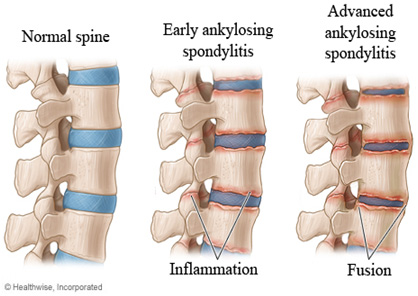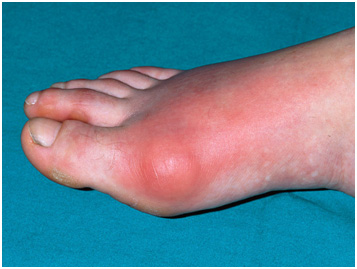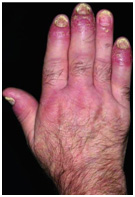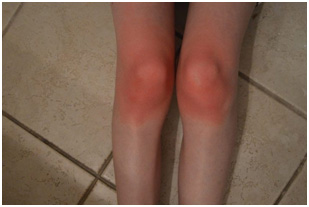Arthritis:- Inflammation of a joint
 Common arthritic joint symptoms include swelling, pain, stiffness and decrease range of motion. Severe arthritis can result to chronic pain, inability to do daily activities and difficult to walk or climb stairs. Arthritis can cause permanent joint changes
Common arthritic joint symptoms include swelling, pain, stiffness and decrease range of motion. Severe arthritis can result to chronic pain, inability to do daily activities and difficult to walk or climb stairs. Arthritis can cause permanent joint changes
Osteoarthritis: Osteoarthritis is a degenerative joint disease that involves the degradation of joints, articular cartilage and subchondral bone.
Common symptoms of osteoarthritis include pain, stiffness, tenderness, limited range of motion. Pain is usually worse after activity.
 Rheumatoid arthritis: Rheumatoid arthritis is an inflammatory arthritis that affects nearly 1% of the world's adults. It is characterized by symmetric polyarticular inflammation of the synovium, typically of the small joints of the hands (MCP and PIP), wrists and feet.
Rheumatoid arthritis: Rheumatoid arthritis is an inflammatory arthritis that affects nearly 1% of the world's adults. It is characterized by symmetric polyarticular inflammation of the synovium, typically of the small joints of the hands (MCP and PIP), wrists and feet.
This inflammation results in pain, stiffness, and can lead to progressive joint damage resulting in deformities and loss of function. Associated organ damage also contributes to severe disability.
Reactive arthritis: is defined as an asymmetric arthropathy involving predominantly joints of the lower extremities plus one or more of the following: urethritis, cervicitis, dysentery, mucocutaneous lesions, and inflammatory eye disease. Reactive arthritis can follow infections with Shigella, Salmonella, Campylobacter, or Yersinia. Arthritis affects several joints in an asymmetric fashion; knees and ankles are often involved. The mucocutaneous lesions of reactive arthritis include oral ulcers, balanitis, and keratoderma blennorrhagia
 Ankylosing spondylitis: Ankylosing spondylitis is an inflammatory arthritis involving sacroiliac joints and the spine. Inflammation also occurs at sites of tendon and ligament insertions. Peripheral arthritis is less common.
Ankylosing spondylitis: Ankylosing spondylitis is an inflammatory arthritis involving sacroiliac joints and the spine. Inflammation also occurs at sites of tendon and ligament insertions. Peripheral arthritis is less common.
Patient initially notes low back pain and stiffness, especially in the morning. The stiffness of the back lasts for several hours in the morning and occurs after periods of activity during the day. The pain might radiate into either buttock, extend down the back of the leg to the knee, and can be mistaken for the pain caused by herniated disc.
 Gouty arthritis: Acute gouty arthritis results from the inflammatory reaction to urate crystals in the joint space or are released into the joint from synovium or articular cartilage
Gouty arthritis: Acute gouty arthritis results from the inflammatory reaction to urate crystals in the joint space or are released into the joint from synovium or articular cartilage
Gouty arthritis occurs mainly in middle-aged and older men and after menopause in women. Approximately one-fourth of the patients have a family history of gout. The first attack occurs most often in the MTP joint of the great toe.
In untreated cases, the attacks become more frequent and involve other joints, such as wrists, elbows, olecranon bursae, and the small joints of the hand.
 Psoriatic arthritis: Hereditary factors play a role. An increased prevalence of psoriatic arthritis occurs in first-degree relatives with psoriasis. The majority of patients have an asymmetric oligoarthritis involving the proximal joints of the hands and feet.
Psoriatic arthritis: Hereditary factors play a role. An increased prevalence of psoriatic arthritis occurs in first-degree relatives with psoriasis. The majority of patients have an asymmetric oligoarthritis involving the proximal joints of the hands and feet.
 Lupus arthritis: Almost 90% of the lupus patients suffer from joint and muscle pain. The disease produces pain and swelling of the joints accompanied by morning stiffness. Areas far away of the body are mostly affected eg, fingers, wrists, knees, feet, toes, elbows and hands. The effect of Lupus arthritis is symmetrical, for example, attacking identical joints on both sides of the body.
Lupus arthritis: Almost 90% of the lupus patients suffer from joint and muscle pain. The disease produces pain and swelling of the joints accompanied by morning stiffness. Areas far away of the body are mostly affected eg, fingers, wrists, knees, feet, toes, elbows and hands. The effect of Lupus arthritis is symmetrical, for example, attacking identical joints on both sides of the body.
Arthritis associated with gastrointestinal disease: Both ulcerative colitis and Crohn's disease are associated with peripheral arthritis and spondylitis. The arthritis usually follows the onset of colitis by months to years and involves only one or two joints
Management
Pharmacological management
Traditional DMARDs
Glucocorticoids
Immounosuppresive therapy
Anticytokine therapy